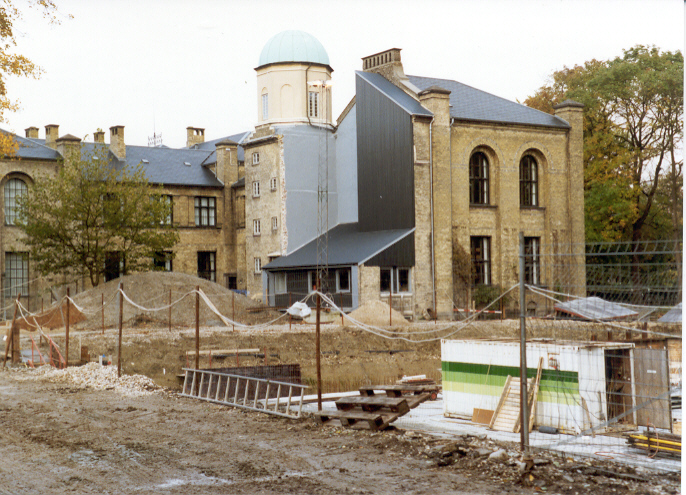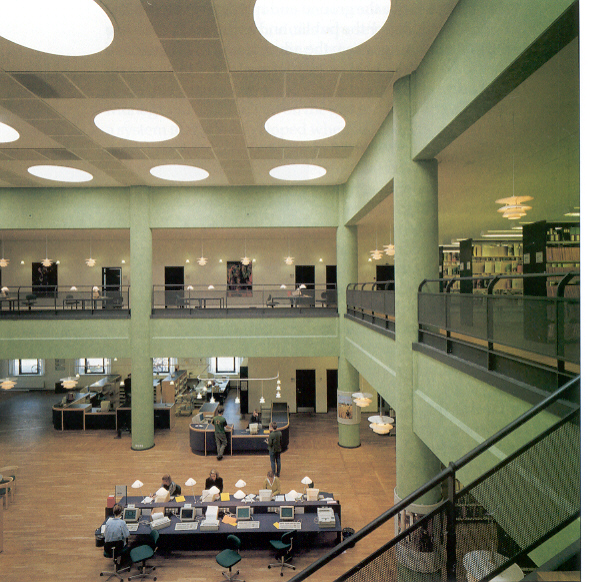History of the library
Peter Christian Abildgaard
The foundation of the library is Abildgaard's book collection
Peter Christian Abildgaard (1740-1801), physician and naturalist, became Denmark's first veterinarian and founded the Veterinary School in Christianshavn in 1773. In 1783, the Veterinary School's library was established by purchasing Abildgaard's private book collection - 1219 works in 2156 volumes. The collection was registered in a handwritten catalog upon handover. The books from the collection are today marked with Abildgaard covers, but are otherwise arranged among the other books in the old collection - before 1950.
Ruini: Anatomia del Cavallo ... (1618) - registered as the first in Abildgaard's Catalogus
Abildgaards Catalogus
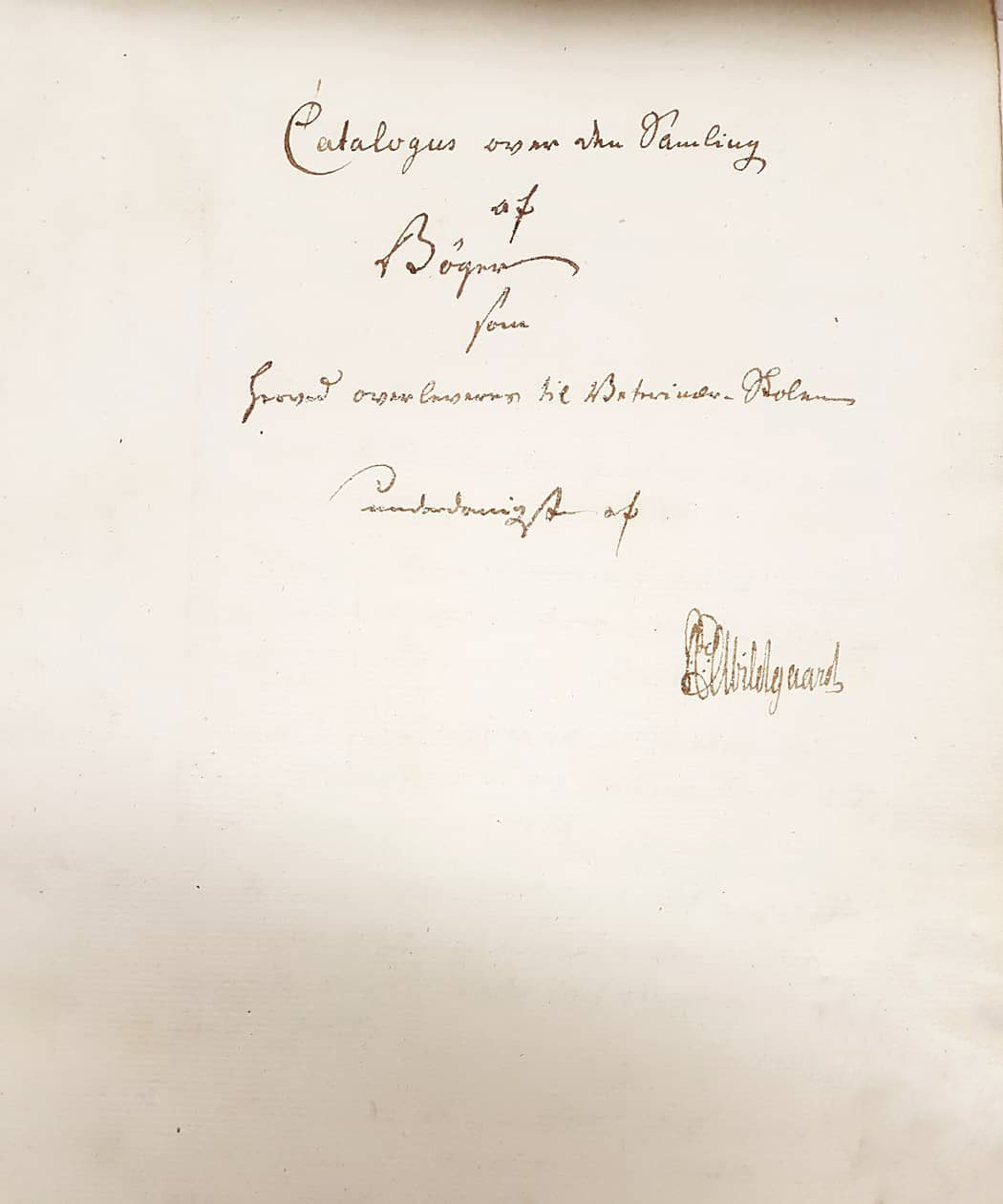
More catalogs
Erik Viborg (1759-1822), originally a botanist, became the second teacher at the Veterinary School from 1783 and succeeded Abildgaard as principal after his death. On a study trip in 1787-90, he purchased a large collection of books, which were included in the library - especially current subject books of the time in French, German and English, but also fine, old books from the 15-1600s. The seals of Viborg and the Veterinary School are stamped in the books and this collection is also registered in a handwritten catalogue. Viborg also acquired many books for the library in the future - e.g. by exchange links with the network of colleagues at the European Veterinary Schools.
Samuel Collins: A systeme of Anatomy ... (1685) - registered as the first in Viborg's catalogue
The library's first protocol/stock catalog: Alphabetical Catalog of the Veterinary Library - is a worn, handwritten work tool, in which the increase has been continuously noted.
1828 and 1840 a complete Alphabetical List of the respective veterinary and other books in the library - including these handwritten ones.
A new library at a new educational institution
The first printed catalog was published in 1858 - for a new library that was to serve a larger educational institution. Henrik Carl Bang Bendz (1806-82) was responsible for this catalogue, for the library and for the new arrangement of the book collection. He was originally a doctor and naturalist and was associated with the Veterinary School as a teacher from 1837. He was the prime mover for the establishment of the Landbohøjskolen in 1858 in Frederiksberg, which, in addition to veterinary medicine, was to teach agriculture, horticulture and forestry. The library was now called Den Kongl. Veterinair- og Landbo-Høiskoles Bibliothek, KVLB. 1867-71 several larger collections were incorporated - from the Forestry Institute, the agricultural economics department of the Classen Library and natural science duplicates from the University Library. In 1873, a new, printed stock catalog was published and later a number of supplements. The library was not yet larger than could be accommodated in one room - shared by books, librarian and users, but by 1890 the book collection had grown to over 20,000 volumes, so shelves had to be raised and some moved into magazines. Opening hours were very limited until 1890 - only 3 x 1 hour a week.
Lending and Reading room approx. 1900
The first card index
Vilhelm Grundtvig (1866-1950), MA, became the first full-time librarian. He was very active during the 10 years he worked at the library - 1892-1903. He published a printed catalog of the entire book collection up to and including 1894 and, moreover, he established for the first time an alphabetical and systematic card catalog, where the increase could be continually added to maps. This index was in use until 1950. He also drew up a new and very comprehensive system, according to which the literature was arranged - until 1950. The old collection is still arranged according to this system in the magazines. In 1894, two large book stores were built in KVL's new building facing Bülowsvej and the librarian got his own office, separate from the Lending and Reading Room. The stock had grown to over 30,000 volumes in the year 1900 and the number of current professional journals was approx. 250. The full-time librarian also benefited the users in the form of better opening hours. From 1890 the opening hours were 2 hours and from 1901 3 hours daily. The reading room had a special 12-hour opening time for KVL employees with a key.

The book collection is growing rapidly
Raphael Meyer (1869-1925), cand.mag., was librarian from 1903 until his death. In his time, the large stock catalog from 1894 was supplemented with several supplements and finally in 1921 with a large, combined supplement for the growth 1895-1916. This catalog was the last printed catalog and it is larger than the catalog from 1894. The library's book collection had thus been increased by more than 50 percent in 20 years - i.a. included several, larger book collections from KVL teachers. Several special collections were also included - i.a. working drawings for gardens and parks from Edvard Glæsel (1858-1915) - the great landscape architect of the time. His fine book collection was also included and can be found today in the books' bookplates. Many of the library's finest books on gardening are from Glæsel's book collection.
One librarian and one assistant
Space problems had again become urgent with the large increase, and in 1921 the majority of the library moved into a newly built library wing on several floors, where for a time there was room for the large and ever-growing book collection. This building was demolished in 1993 in connection with the building of the new library. In 1908, the staff included 1 assistant in addition to the librarian. In 1908, the book stock had grown to approx. 40,000 volumes.
The old library building
 |
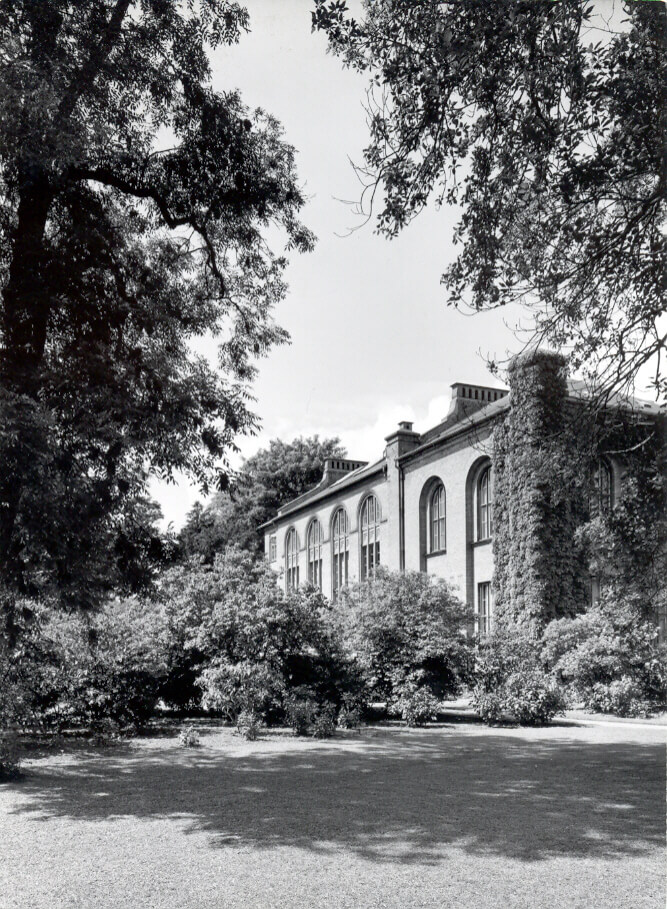 |
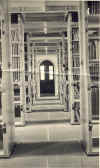 |
In the long period - 1925-61 - when cand.mag. Max Lobedanz (1888-1961) was chief librarian, the staff grew somewhat more - in line with the growth in materials, assignments, opening hours etc.
Lending and reading room in the 1930s - still a male-dominated world
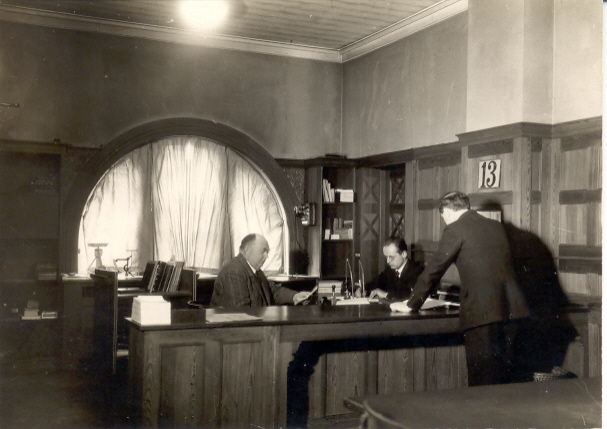 |
 |
"Free Denmark"
Resistance fight at the Landbohøjskolen
During the war, the resistance also spread to the Agricultural College, and right into the library. From the autumn of 1943, a group of four people - then docent and later professor Aksel Milthers, master of arts and research librarian Leo Buschardt, bookbinder Svend Aage Nordsund and cand. mag. and librarian Vibeke Ammundsen - initiative to print and distribute the illegal magazine "Frit Danmark" to agricultural circles via the library. The printing of the magazine took place in an office in the library behind blackout curtains by putting text on stencils and printing on an old hand-operated duplicator.
Bookbinder Svend Aage Nordsund and research librarian Leo Buschardt at the duplicator
Chief librarian Max Lobedanz turned a blind eye to the activities, but granted a new and slightly better duplicator at Vibeke Ammundsen's request. Circulation increased from 500 copies a week to 4,000, which had to be transported from the library to mailboxes or post offices. Of course with a fake sender address!
Librarian Vibeke Ammundsen as fire guard 1943
Free Denmark's Agricultural Group came through the war unscathed and I wonder if they also met the several hundred resistance fighters who gathered on the Landbohøjskolen's grounds during the liberation in 1945?
 |
Sources: Vibeke Ammundsen: Frit Danmarks Landbrugsgruppe i Ugeskrift for Jordbrug, 1983, nr. 41. S. 841-845.
Modstandsbevægelsen her paa Landbohøjskolen. K.V.L.Bladet. Udgivet af De Studerendes Raad ved Den Kgl. Veterinær- og Landbohøjskole. 1945, 9. Aargang, nr. 1. s. 8-9.
Women and copies
In 1958, the staff numbered 12, several of whom were women, and that was something completely new! Copying was one of the new tasks from 1942, and another time-consuming service was the publication in 1947 of a journal index on notes, where articles from approximately 1,500 journals were indexed. The book collection had grown to over 200,000 volumes by 1958, and the library was gradually filled to the brim. Extra shelves were put up everywhere and a low basement was filled up - to great inconvenience for the daily expeditions from here on out for many years to come!
Basement with poor space conditions
The system had gradually become obsolete. From 1950 a new system was introduced for the classification of books, but only when registering in the card indexes, which now had to be consulted before every expedition. To save as much space as possible, the books were arranged compactly in numerical order, while the journals were arranged by title within the main groups of the new system.
Lack of space and a new name
Helge Nielsen (1918-1999), cand.mag., was chief librarian 1961-78. He fought throughout the years for a new library, but in vain. The growth in materials was increasing rapidly - not least with journals as the most space-consuming. Much effort was spent on relocations and remote storage, and each summer it gradually had to close for 2-3 weeks to cope with the major reshuffles. Cooperation agreements were concluded with the other Nordic agricultural libraries and reporting to AGRIS - FAO's bibliography of agricultural literature - was begun. In 1969, the library changed its name to the Danish Veterinary and Agricultural Library, DVJB.
|
Room for Library staff
|
Photocopying
|
Busy lending
|
Introduction of computers
Inge Berg Hansen (1939-2012), lic.tech., was head librarian from 1978 to 1986. She and her staff were active in introducing computers to the library, so that the library could participate in the research libraries' first attempts at computer cataloging into a common database. Later, the library got its own online catalog, but for the time being only by connecting to the Technical Library of Denmark's catalog system ALIS.
The technology of the time was terminals, which in the first years were only for staff, but in 1986 terminals were also set up for the public so that they could search for themselves. The card catalog was closed. Another era was over. In 1979, a Documentation Center was established with the special task of carrying out online searches for a fee for, among others, the business community.
|
Lending room 1983
|
Online Searching
|
The new library building
It was not until the 1990s that major, decisive improvements were made, while Inger Mathiesen (1935- ), cand.mag., was head librarian (1987-98). The miserable physical environment for users, staff and materials in the old library is clearly remembered by all of us, who can now enjoy the functional and beautiful environment of the new large library, which was finally completed in 1995, every day. There is plenty of space for the materials here, with open access to the newer collections of books and journals.
|
Excavation for the basements
|
The finished library - outside 1995 |
The finished library inside 1995
|
In 1992, the library was one of the last research libraries in Denmark to have its own computer system. From then on, all additions were registered in the online catalogue Agroline and since 2002, all older registrations from the card indexes have also been made available electronically. PCs became standard and more and more resources became available digitally. The library's website became the virtual main entrance to the diverse range of services.
The move into the new library was marked, among other things, by the publication of the book about the library's history:
Book by book ... year after year. The history of the Danish Veterinary and Agricultural Library 1783-1995 by Ivan Katic. (In Danish)
Electronic resources and study environment
Librarian Ulla W. Jeppesen (1944- ) was chief librarian from 1999 to 2005 - a time of explosive growth in access to electronic resources. With online access to most journals in digital form, it became possible to significantly clear out the space-consuming journals in paper form. The entire first floor of the library, which had previously been filled with shelves of journals, could now be cleared out and make room for an open and attractive study area with room for even more PCs. In 2004, 2.3 km. of journals were discarded or moved to the lower floor, where the remaining journals in paper form are openly available from 1990. A wireless network has been established in the library as on the entire Campus, so that everyone has easy access from their own laptop.
|
1st floor 1995 (where the Quiet Area is now)
|
1st floor 2004 (where the reading room is now)
|
University merger and a new name
Librarian Frede Mørch (1950- ) was head of the library in 2005-15. It was a period of several organizational changes as a consequence of the major university mergers. From 2007, KVL became the Faculty of Life Sciences, LIFE under the University of Copenhagen, University of Copenhagen. The library thus became a faculty library and at the same time part of the library community KUBIS, which brings together the libraries under the University of Copenhagen - among other things with a common catalogue REX and with joint purchasing of most electronic resources. From 2008, the library's name became the Faculty of Life Sciences Library, BVFB. From 2009, the opening hours have been extended, so that it is open weekdays from 8 am to 8 pm and weekends from 10 am to 5 pm.
Indgangspartiet, dekoreret af Line Knutzon.

Merger/fission and new name - again
From 2012, new organizational changes followed, as LIFE was closed down as an independent faculty and distributed with veterinary institutes under SUND and the rest was merged with Nat as SCIENCE - The Faculty of Natural and Life Sciences. With this, the era of the Agricultural University was finally over - as an independent university 1858-2006 and as a unified LIFE Faculty under the University of Copenhagen 2007-11.
The consequence for the library was clarified with the evaluation after 5 years with KUBIS in October 2012. The library remains an independent library under the University of Copenhagen as the central library for Frederiksberg Campus - now only distributed between 2 faculties - SCIENCE and SUND. From April 2013, we were given a new name that reflected this reality: The Faculty of Natural and Life Sciences Library - Frederiksberg Campus.
The second library serving these faculties is located at Nørre Allé 49 and has been given the same overall name with the addition Nørre Campus.
KUB Frederiksberg
Librarian Marianne Grützmeier (1954- ) became the new head in spring 2015, when the library was again renamed in connection with a general simplification of the names of the University of Copenhagen libraries from KUBIS to KUB: Copenhagen University Library - Frederiksberg or in short: KUB Frederiksberg. In spring 2015, a long-awaited new quiet reading room with attractive study spaces was inaugurated. Almost all the focus is on e-resources, e-learning and digital dissemination.
Indvielse af stillelæsesal

The library has also become visible and active on social media since 2015.
Facebook.com/kubfrb and @universitetsbiblioteket on Instagram.
New interior design in Atrium
Changes were once again in focus in 2016/17. The imposed savings had consequences for the library in various ways. Co-location in the building with Science IT Service and Warehouse meant less space for the library's materials, with even more having to move to the basement storage, so all direct access to the physical journals ceased, except for a few Danish professional journals, which are now on vacant shelves in Atrium. Remaining books from Atrium were collected in the basement, where users still have direct access to newer books from 1993 onwards.
Savings also meant an unmanned counter on weekdays between 8-10 am. In return, the physical layout in Atrium received a qualitative boost with a special grant for a new lounge area at the entrance and a unique counter centrally located in the room, where new colors, lamps, furniture and carpets also contribute to an attractive environment.
An era ends... a new one begins
The turn of the year 2017/18 marked the end of 234 years of history as an independent library, as KUB Frederiksberg was transferred to the Royal Library and at the same time administratively merged with KUB Nord as a joint library for the two largest faculties at the University of Copenhagen - Science and Health. Both physical libraries will continue as the local bases for collections, services and study environment for Nørre Campus and Frederiksberg Campus respectively. Librarian Bonnie Frisendahl (1984- ) is the new head of the joint library from April 2018.
The green walls turn white and a new community is formed
In 2019, the library will undergo a renovation, where the familiar green walls that have characterized the building since 1995 will disappear in favor of white walls. The room will be newly furnished with a strong focus on creating even better reading and seating areas for students and being an attractive study environment regardless of whether space is needed for group work or quiet spaces for immersion and exam reading. A number of conversation rooms will also be built for Science Student Services on the ground floor for student advice, and Student Services will also establish a call center in the basement of the building.
However, it did not take long before all parties had to say goodbye to the new premises for a while. The library's employees, like other public employees in educational institutions and libraries, will be sent home on March 11, 2020 due to the covid 19 epidemic. In the long history of the library, no one would have predicted that there would come a day when we would have to have the library run and function from home. But it turned out that we were well equipped to take on this sudden challenge. Many tasks could be completed from home and many services were already digitized for users, for example, journals and books can be accessed online and teaching students in literature searches and reference management turned out to be able to run over Zoom.
Supporting research registration and digital education
It is not only the physical library that has changed since the library was founded. The tasks of the library staff have also changed. Many of the classic library tasks such as cataloguing, licensing, purchasing and interlibrary loans have been centralized at the Royal Library and today the library staff work in a team structure that reflects the library's overall tasks of supporting university employees and students: Research Services, Teaching, User Services and Communication. At our sister library at Nørre Alle there is also a Datalab team that specializes in data management - including harvesting, cleaning, analysis and visualization of data.
We continue to develop our study environment to create good frameworks for well-being and learning, and teaching students information skills such as source criticism, literature search and reference management greatly supports students in their study life - and further into their working life.
240th Anniversary
In 2023, the Veterinary School celebrated its 250th anniversary, and the library was thus able to celebrate its 240th anniversary and still be the world's oldest veterinary library. The Veterinary School's 250th anniversary was celebrated in several ways - including an open house on campus and an anniversary book, to which the library also delved into the collections to contribute images and research.






